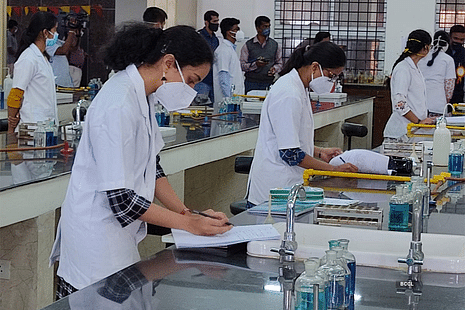To enhance the regular preparation for NEET UG 2025, candidates should practice some questions daily. Here are NEET Daily Practice Questions for 4 January 2025.
 NEET Daily Practice Questions 4 January 2025
NEET Daily Practice Questions 4 January 2025NEET Daily Practice Questions 4 January 2025: Aspirants preparing for the NEET 2025 shall refer to the below-mentioned NEET Daily Practice Questions 4 January 2025. These questions cover important topics from subjects like physics, chemistry, and biology. They can analyze their strengths and weaknesses in a particular subject by working through these questions and reviewing the answers. It can help them to perform better in the upcoming NEET 2025 exam.
Also Read | JEE Main Daily Practice Questions 4 January 2025
NEET Daily Practice Questions 4 January 2025: Physics
Here are some of the NEET daily practice questions with answers 4 January 2025:
Question 1: Body A of mass 4m moving with speed u collides with another body B of mass 2m, at rest. The collision is head- on and elastic in nature. After the collision the fraction of energy lost by the colliding body A is:
1. 5/9
2. 1/9
3. 8/9
4. 4/9
Answer: (3)
Question 2: When an object is shot from the bottom of a long smooth inclined plane kept at an angle of 60° horizontally, it can travel a distance x1 along the plane. But when the inclination is decreased to 30° and the same object is shot with the same velocity, it can travel x2 distance. Then x1: x2 will be:
1. 1:2(3)^½
2. 1:(2)^½
3. (2)^½:1
4. 1:(3)^½
Answer: (4)
Question 3: The work done to raise a mass m from the surface of the earth to a height h, which is equal to the radius of the earth, is:
1. 3/2 mgR
2. mgR
3. 2mgR
4. ½ mgR
Answer: (4)
Question 4: The total energy of an electron in an atom in an orbit is -3.4eV. Its kinetic and potential energies are, respectively:
1. 3.4 eV, 3.4 eV
2. -3.4 eV, -3.4 eV
3. -3.4 eV, -6.8 eV
4. 3.4 eV, -6.8 eV
Answer: (4)
Question 5 : In which of the following processes, heat is neither absorbed nor released by a system?
1. isochoric
2. isothermal
3. adiabatic
4. isobaric
Answer: (3)
NEET Daily Practice Questions 4 January 2025: Chemistry
Here are some of the NEET daily practice questions with answers 4 January 2025:
Question 1: Which is the correct thermal stability order for H2E(E = O, S, Se, Te and Po)?
1.H2Se < H2Te < H2Po < H2O < H2S
2. H2S < H2O < H2Se < H2Te < H2 Po
3.H2O < H2S < H2Se < H2Te < H2 Po
4. H2Po < H2Te < H2Se < H2S < H2O
Answer: (4)
Question 2: Enzymes that utilize ATP in phosphate transfer require an alkaline earth metal (M) as the cofactor. M is:
1. Sr
2. Be
3. Mg
4. Ca
Answer: (3)
Question 3: 4d, 5p, 5f and 6p orbitals are arranged in the order of decreasing energy. The correct option is:
1. 5f>6p>4d>5p
2. 5f>6p>5p>4d
3. 6p>5f>4d>5p
4.6p>5f>4d>5p
Answer: (4)
Question 4: If the rate constant for a first order reaction is k, the time (t) required for the completion of 99% of the reaction is given by:
1. t=2.303/k
2. t=0.693/k
3. t=6.909/k
4. t=4.606/k
Answer: (4)
Question 5:
Which of the following diatomic molecular species has only π bonds according to Molecular Orbital Theory?
1. Be2
2. O2
3. N2
4. C2
Answer: (4)
NEET Daily Practice Questions 4 January 2025: Biology
Here are some of the NEET daily practice questions with answers 4 January 2025:
Question 1: The appearance of recombination nodules on homologous chromosomes during meiosis characterizes:
1. Terminalization
2. Synaptonemal complex
3. Bivalent
4. Sites at which crossing over occurs
Answer: (3)
Question 2: Which one of the following statements is not true regarding gel electrophoresis technique ?
1. Bright orange coloured bands of DNA can be observed in the gel when exposed to UV light.
2. The process of extraction of separated DNA strands from gel is called elution.
3. The separated DNA fragments are stained by using ethidium bromide.
4. The presence of chromogenic substrate gives blue coloured DNA bands on the gel.
Answer: (4)
Question 3: The gaseous plant growth regulator is used in plants to:
1. kill dicotyledonous weeds in the fields
2. speed up the malting process
3. promote root growth and root hair formation to increase the absorption surface
4. help overcome apical dominance
Answer: (3)
Question 4: Read the following statements about the vascular bundles:
(a) In roots, xylem and phloem in a vascular bundle are arranged in an alternate manner along the different radii
(b) Conjoint closed vascular bundles do not possess cambium
(c) In open vascular bundles, cambium is present in between xylem and phloem
(d) The vascular bundles of dicotyledonous stem possess endarch protoxylem
(e) In monocotyledonous root, usually there are more than six xylem bundles present
Choose the correct answer from the options given below:
1. (a), (c), (d) and (e) only
2. (a), (b) and (d) only
3. (b), (c), (d) and (e) only
4. (a), (b), (c) and (d) only
Answer: (1)
Question 5: Which of the following is incorrectly matched?
1. Volvox - Starch
2. Ectocarpus - Fucoxanthin
3. Ulothrix - Mannitol
4. Porphyra - Floridian starch
Answer: (3)
| Also Read | |
|---|
| JEE Daily Practice Questions 3 January 2025 |
| NEET Daily Practice Questions 3 January 2025 |
Keep visiting CollegeDekho for the latest Education News on entrance exams, board exams and admissions. You can also write to us at our email ID news@collegedekho.com.
Are you feeling lost and unsure about what career path to take after completing 12th standard?
Say goodbye to confusion and hello to a bright future!

NEET Previous Year Question Paper
Was this article helpful?





 Follow us
Follow us













